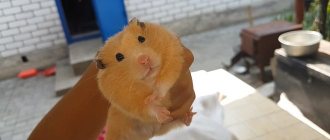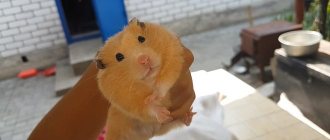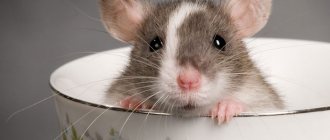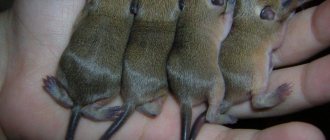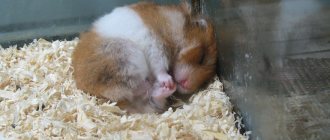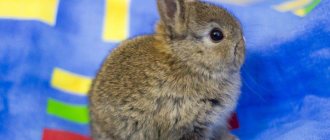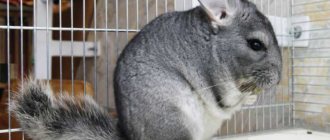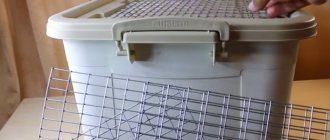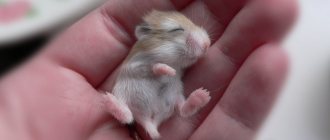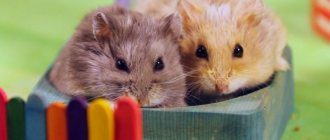Syrian hamster
photo can be enlarged
Hamsters are small, densely built rodents with short limbs, small ears and short tails. Body length varies from 5 to 34 cm, tail length from 0.7 to 10 cm. Females in some species are larger than males. The color of the thick fur on the back ranges from ash or brownish-gray to dark brownish-ochre. The fur on the belly is black, white or grey. Sometimes there is a black stripe along the back. There are very developed cheek pouches.
In nature, hamsters are found in Central and Eastern Europe, Asia Minor, Syria, Iran, Siberia, Mongolia, northern China and Korea. Hamsters live primarily in open, arid landscapes, most often in forest-steppes, steppes, semi-deserts and deserts. In the mountains they are found at altitudes of up to 3600 meters. They also inhabit anthropogenic landscapes: fields, gardens.
Blue Syrian hamsters, baby photos can be enlarged
Hamsters are terrestrial animals, although some species swim well, taking air into their cheek pouches. Most species live solitarily, digging complex burrows in the soil. They almost never go into true hibernation, but they can go into prolonged torpor. They feed mainly on plant and partly animal food, mainly seeds. Many species store food reserves for the winter, sometimes up to 90 kg.
These rodents are very prolific, producing 2–4 litters per year. The pregnancy of a female hamster lasts 15 - 22 days. In a litter there are most often from 1 to 18 cubs, which reach sexual maturity already at 6-8 weeks. The lifespan of a hamster in its natural environment is 1-3 years; in captivity, such pets live for about 3 years. Hamsters are hunted in the wild by numerous predators, including red and black kites, buzzards, lesser spotted eagle, fox, stoat and badger. Young animals are attacked by kestrels, gray herons, carrion crows, and rooks.
How to make clothes for a hamster with your own hands
As you know in the summer, all hamster owners run outside on the hottest day and walk their hamsters. But many hamsters suffered because their owners do not know how to do this!
We will tell you how to do it correctly and safely! 1) Take a container (closed) with holes approximately slightly smaller than the hamster’s head.
2) put toilet paper or COTTON FABRIC WITHOUT ADDITIVES in it.
3) dress the hamster in a protective suit (all information about it is given below)
4) put the hamster in a container.
5) we go outside with a container and a hamster in it, holding the container with the animal in our hands (so that the hamster feels protected with the owner, and hold the container so that your hamster can see you.
6) Do not pick up or put your hamster out of the container during a walk.
7) you should only walk in the SUMMER and only IN EXTREME HEAT, NO MORE THAN 1 TIME A WEEK.
8) do not allow contact with other animals
9) the walk should take no more than half an hour!
10) after a walk, hold it in your arms for 5 minutes in the apartment (so that the hamster calms down.
11) put the hamster in a cage and do not touch him for 2 hours, put a treat in his food.
HAMMster COSTUME FOR WALKING.
You are on the street. There are a lot of mosquitoes, flies, wasps, and midges around you. All of them can bite your pet, what should you do? Clear! Need a protective suit!
0) think about how you will put the costume on the hamster.
1) decide what you will do.
2) choose fabric, but not lace, preferably regular cotton, white fabric.
3) carefully measure: the hamster's butt, tummy, head, neck, length of the legs, and the full height of the hamster.
4)carefully draw the drawing on a sheet of paper.
5) transfer the drawing on paper to the fabric.
6) on fabric add 2 cm to the entire drawing
7) cut out all the details from the fabric separately.
8) sew it all together so that nothing bothers the hamster.
9) you can come up with decorations for your animal’s costume.
but keep in mind that the fabric should be light, you need protection on your paws, head, torso, and butt.
Source
This is interesting
The largest hamster in the world
. The common hamster is considered not only the largest, but also the most beautiful among its fellows. Its size is truly impressive. An adult reaches 25–30 centimeters in length. It has an extremely bright, rich red coat color on the back, a black belly and three white spots on the side of the head, chest and sides. The nose and paws are white. Although sometimes there are individuals of black and white or black color.
The smallest hamster in the world
. Among all domestic hamsters, Roborovsky's hamsters are the smallest. They reach only five to six centimeters in length. Their back and head are yellow-sand in color. But the belly and fur around the antennae are almost white. A distinctive feature of this breed of hamsters are light, almost transparent “eyebrows”. The movement of these funny animals across their territory is so rapid that their owners can mainly only observe their beloved pets. In addition, this type of hamster is characterized by increased nervousness, and moving them in the external environment or changing the environment becomes real stress for them, which can last up to several weeks.
Some hamsters may begin to chew on the cage or objects in it, and this can be corrected by giving the hamster cookies or putting chalk in the cage. Dog treats are good - they will not harm the hamster's teeth, nor are they harmful to health or digestion. But it is very important that the hamster has food or objects with which he can grind his teeth - if this is not the case, the constantly growing teeth can puncture the jaw.
Hamsters see in black and white, but at the same time they have very poor eyesight. Hamsters rely primarily on hearing and smell.
The Vietnamese authorities have banned the keeping of hamsters, rightly considering them carriers of dangerous diseases. The reason for such measures was the massive import of animals that had not passed veterinary control from abroad, which was associated with the onset of the Year of the Rat according to the eastern calendar and an increase in demand for small rodents. The maximum fine for violating the ban is 30 million dong, which is about 57,000 rubles, and is comparable to the annual income of a resident of this country.
What things can you make?
In general, you can create anything for a hamster from scrap materials. The main thing here is ingenuity, desire and accuracy. Things for a pet can be made from a variety of materials, so they will cost almost free.
Here are some crafts you can make for hamsters with your own hands:
- The cage is temporary and permanent. For construction you will need a fine metal mesh and wood for the frame.
- Drinking bowl. It is easy to make from a ballpoint pen and a small plastic bottle.
- Little house. Any materials are suitable for building a shelter.
- Sports equipment: ladders, climbing frames, slides, running wheel.
- Entertainment: tubes for hamsters and their weaving (labyrinths), a walking ball, swings and other attractions. You can create a whole park for your hamster with your own hands, if the size of your living space allows.
- Furniture: Various hammocks, lockers, bunkers and even a hamster litter box!
The list can be continued for a long time, because human imagination is endless. And if you have young advisers and masters, then soon your pet’s home will be completely transformed! But when creating things, remember that they must be safe for the hamster.
Playground
Toys for your pet do not have to be placed strictly within the cage. A separate playground will result in even greater joy for your pet and benefits for his health. Regardless of what will act as this - a large box or something else, the hamster's playroom must be fenced, otherwise the furry fugitive will have to be caught throughout the house.
When equipping an entertainment area for your pet, it is worth including both specialized toys (running wheel, tunnels, sandbox, bridges, etc.) and simple objects that are safe for the hamster and suitable as sports equipment. For example, the animal will happily climb onto blocks from children's sets. If possible, you can place a labyrinth or obstacle course on the site.
A hamster's playroom separate from the home should be equipped with a feeder and drinking bowl. An overplayed animal needs the opportunity to replenish its strength at the right moment. It wouldn't hurt to have a bed so that the fluffy can rest. But if you wish, you can place a hammock in the play area instead.
What to build from?
The material is very important. If the furniture is made of toxic substances, the hamster will experience choking attacks or allergies. Therefore, try to use sharp-smelling adhesives like Moment to a minimum.
So, here's what's suitable for construction:
- wood and plywood;
- non-toxic plastic (water bottles, food containers);
- glass and ceramic objects.
- household waste: Popsicle sticks, 5-liter bottle caps, packaging boxes, cardboard tubes, old toys and other rubbish.
Tools are selected individually depending on the complexity of the work. It is better to fasten parts with nails, a stapler, PVA glue, tape or electrical tape. As a last resort, you can use superglue, but in those places that the homa cannot chew.
When children take part in the process, they want to color everything. Explain to the child that it is better not to use gouache for this purpose, because it will stain the animal’s bedding and fur. Water-based paint, wax crayons, or alcohol-based markers are good alternatives.
Actions with a hamster and the nuances of sleep
The hamster is identified with thriftiness - it is a thrifty animal and usually sleeping with it is viewed from a financial point of view. But since the animal is weak both mentally and physically, and is also greedy and stingy, the interpretation can be both positive and negative. Depending on what the dreamer does in his dream
, can be deciphered point by point:
It is very difficult to catch a moving animal and hold it in your hands, and if you succeed, then such a picture symbolizes good luck in reality, a valuable gift, profit and a successful deal. The subconscious says that the sleeper is in control of his life and is able to plan. But if the caught hamster dies, or the dreamer kills it, such an image foreshadows misfortune, moreover, created through the fault of the owner of the dream. Do not forget that this is only a warning and everything can be corrected; it is important to respond to the signals of the subconscious in a timely manner.
Animal occupation
A happy and contented hamster stuffing its cheeks with food predicts financial stability. A person’s thriftiness and thriftiness, according to such a dream, can develop into stinginess, so storing money and valuables to the point of “Plyushkin” is not worth it.
A dream in which you dream of a hamster sitting in a cage foretells good luck, and it is not going anywhere. It also means changes in life. Both the dreamer’s hard work and the help of strangers will contribute to well-being. If the picture shows a sleeping animal, you need to be careful, since deception and betrayal on the part of others is possible.
An animal running in a wheel symbolizes movement towards a goal. Thanks to hard work, the planned event will certainly come true, but we should not forget about rest. Having received information, it is necessary to rethink it and correctly plan actions in reality, then all troubles will be avoided.
Number of rodents
If you dream of a lot of hamsters running around the floor, then this means new acquaintances with useful people, thanks to whom new sources of income and budget replenishment will appear. some soothsayers decipher such a vision as errors and wrong decisions in financial matters, therefore, if the dreamer’s activities are related to material values, it is recommended to check the documents. If animals are in a public place associated with making a profit, then a business meeting or transaction may not take place.
A small economic animal is basically a favorable symbol; it is important that the animal feels good, is treated with care and love - then prosperity awaits in reality. Psychologists also regard a large number of fur-bearing animals as a sign of remorse for pettiness and greed.
Breed and color
The meaning of the dream depends on the color of the hamster and its breed. Thus, an animal of Syrian origin prophesies waste that will not bring pleasure or benefit. You should consider your expenses and avoid unnecessary things. The Dzungarian rodent means a close friend and assistant who you can rely on - he will certainly help you achieve your goals and bring stability. A wild steppe animal symbolizes the influence of outsiders, ill-wishers. You need to take a closer look at those around you and check the documentation of your subordinates.
An albino portends a meeting with a special person who will force you to change your principles and attitude towards the world. Hamsters come in different colors, so in the morning you need to remember the following details:
A hamster is a hard-working animal and without effort and hard work, no plans will come true.
Depending on the gender of the dreamer
If a child talks about a dream about a hamster, then parents should pay attention to the baby’s health. Such a dream could mean digestive problems. In a night adventure, the rodent warns the girl about choosing a chosen one; the admirer may be insincere and you need to take a closer look at him. For the male population, the animal symbolizes all financial issues, prosperity and success in work. A dead hamster for a man means making the wrong financial move.
, bankruptcy and failure.
It is important for a woman to pay attention to the location of the hamster and its actions. The general interpretation is a meeting with a rich man
, joyful events and luck in amorous affairs. But all this will come true when the animal is in your hands, but if it runs away, you should be prepared for expenses that may be caused by children. A rodent as a gift is a very favorable sign that will bring wealth and financial independence.
A few ideas
All hamsters love to have fun on rides. We'll tell you how to do some of them. Especially small animals like to ride down the slide, run up the stairs and explore the labyrinths. We will start with them.
Slide
Although hamsters are cowards, many of them willingly roll down the slide. Learn tips on how to make a hamster slide and make your pet's dream come true!
The best materials for making this attraction are plastic and wood. But the wooden surface must be thoroughly polished, otherwise the hamster will not slide on the slide, and it can also cause splinters on its paws. Here are ideas for creating this thing:
- Straight slide made of wood. Do you have a small smooth piece of wood? The required length is about 20 cm, and the width is 10. Just place it at an angle of 30º to the floor - and you can roll the fluffy one. This is a temporary structure designed for playing with your pet outside the cage.
- A slide of ducks. If your kids have utiki (short skis), they are ideal for playing with your pet. One ski should be taped to any support, with the rounded toe pointing down, it will ensure a smooth landing on the floor.
- Old toys. Many children have doll water parks at home. They will willingly share the slide with the hamster, because playing with the animal is more fun than with soulless toys.
- Shampoo bottle. If you have cylindrical cosmetic bottles left, cut off both ends and cut the bottle lengthwise into 2 parts. Make a ladder with a support from wood. You can also prepare a landing site. Then all that remains is to install half the bottle and roll your furry friend.
Hamster toys
Hamsters living in the wild are constantly on the move. They are forced to look for food, run away and hide from enemies. For domestic animals there is no need for this - there is food, there are no attacks from predators. But a life of safety and prosperity does not relieve hamsters of the need for activity. In order for your pet not to become “fat” and to remain vigorous and healthy, it is necessary to provide him with proper leisure time. The best option is active games. Special devices are designed to help organize them.
Toys for animals should be focused on finding treats and movement. These tasks can be either combined in one multifunctional device or distributed among different devices - monofunctional.
The first include devices containing “hard-to-get” treats. To get to a tasty prize, the hamster will have to try hard - run, rummage, climb, etc. These are any structures where you can hide a treat for the furry champion. Even stairs are included in this category, as the prize can be placed on the top step.
Other toys that do not have a place to hide treats are exclusively sports equipment - these are running wheels, etc. Of course, multifunctional toys can only be used as exercise equipment. But it is important to remember that the animal must have an incentive to exercise. And there is no better incentive for a hamster than the alluring aroma of a treat.
We are building an amusement park!
If you have a free aquarium, you can build a park for your hamster with your own hands. This will not be a living area, but an entertainment room, and a wide variety of attractions can be placed there. Here's what should be there:
- a running wheel (it can be easily made using a bearing from a disk drive and thick cardboard);
- pipes and labyrinths (from cardboard tubes or plastic bottles);
- bridges and stairs made of wood or plastic;
- a recreation room with several entrances.
If there is space left, give your pet a swing or hang a hammock. In order for the homa to stay in the rest room for a large amount of time, a drinking bowl and a bowl of food are also needed. You can also make them yourself or move them out of the cage for a while.
And one more important point: in the permanent rest room, just like in the cage, there must be filler. You will also have to periodically tidy it up, change the bedding and wash all the toys. Only then will your pet’s rest become not only enjoyable, but also safe.
Thus, you can make absolutely all toys for your hamster yourself. This will save a lot of money and will bring pleasure to you and your children. The hamster will be happy to receive toys made by the caring hands of the owner. Of course, some homemade attractions are short-lived, but they are made very quickly, this makes it possible to frequently pamper your pet with new things.
Source
Interpretation of famous dream books
Over the millennia, the experience and research of magicians and soothsayers has accumulated; modern psychologists give their assessment of dreams. The influence of dreams on a person’s future has been proven by world scientists and researchers. The meanings of night images may contradict each other, since with the development of civilization the worldview of mankind has changed:
The interpretations of famous psychologists and seers of both modern times and past centuries are still relevant today. The modern dream book has synthesized many years of data and associates the hamster with material wealth. A well-fed and shiny rodent characterizes the dreamer as a wealthy and thrifty person, prone to stinginess. Actions with an animal and observation of its behavior decipher the dream in a certain way. Keeping a happy and healthy animal in a cage means success in business, but a dead animal means failure and bankruptcy.
Ancient Greek soothsayer Aesop
According to the ancient writer and public figure, the dream indicates a search for solutions to the problem. He associates a large number of animals with monetary profit and treasure. A hamster bite indicates losses and expenses; the vision provides an opportunity to prepare and avoid mistakes. There is no need to rely on others and put aside savings in advance.
If an animal climbs on an object or over an obstacle, then this symbolizes an obstacle in reality on the way to achieving the goal. And the real outcome of the event depends on whether the rodent overcomes the obstacle.
Buying an animal on the market means meeting a rich person who will not share his experience and knowledge. Watching a hamster eat is an unexpected gift or income. You need to carefully observe those around you, so they will influence the future. Hand feeding is a new profitable business. A conversation with an animal prophesies the revelation of a secret.
The prophecies of the clairvoyant Vanga
The Bulgarian seer generally characterizes the hamster as a favorable sign, but at the same time it warns against a shameful act. A pregnant hamster means unfinished business that needs to be brought to its logical conclusion. Only in this case will the dreamer be successful.
A rodent placed in a glass jar or cage that restricts its freedom portends a favorable outcome of affairs, the resolution of financial disputes in favor of the sleeping person. And if a person sees a hamster that is sleeping, this indicates a rethinking of actions and the right direction in life. An animal running away in a dream represents a frivolous approach to business, carelessness. If you follow this path, then profit will bypass.
Psychological explanation according to Freud
Sigmund Freud considers the dream of a pet rodent as a signal of sexual experience and satiety in reality. For a family person, the image means home comfort, intimate satisfaction and happiness, and the desire to have children. An unmarried girl should pay attention to the fatness of the animal: if it is thin and scrawny, then you need to take care of its health, and fat and contented means a new admirer, capable of fulfilling all desires.
Seeing a sick bald rodent for a man means illnesses that will become long-lasting. If an animal sleeps on a bed, this portends a friendly relationship with a partner that will not take a romantic turn.
For a married woman, a vision of a restless animal darting around a cage foreshadows a man’s attempts to manage everything both at work and at home. He should be advised to focus on one thing; he won’t be able to manage everything.
For a lady who has no children, a dream about many rodents predicts childlessness. And for a pregnant woman, the image of hamsters warns about emergency situations, she should take care and stay at home more. A broken cage without a hamster means a rival will interfere in family life, it is recommended to pay attention to the discord in the relationship with your spouse and prevent the breakdown of the family.
magiya.guru
0
what does it mean to make a hamster for a man? Today, a huge number of slang words and expressions, the meaning and origin of which are lost in the fog, fall into everyday speech.
However, on our website fashionable-slova.rf you can decipher many slang terms. In this article we will talk about the relationship between a man and a woman or a guy and a girl, namely, we will analyze the rather popular phrase Make a Hamster
, which means you can read it a little lower. However, before you continue, I would like to recommend you some more popular news on the topic of sex. For example, what does Gachimuchi mean, what is Cum, what does the word Hentai mean, how to understand the term Strap-on, etc. So, let's continue, what does it mean to Make a hamster to a man?
This expression has two possible origins:
First option
. The meaning of this expression is that some drew attention to the similarity of shaggy male testicles with the thick cheeks of a hamster, which he stuffed with grain, and therefore, when a girl takes them into her mouth, a similar association arises.
Second option
. This is when a girl takes a penis in her mouth, after which her cheek stretches, giving the young lady a very funny look. At the same time, she becomes like a hamster who discovered deposits of grain and stuffed her cheeks well with them.
Now many young ladies are quite often interested in what it means to give a hamster to a man
. Therefore, after reading this small but extremely useful article, you will now be aware of the latest trends in sexual fashion.
fashionable-words.rf
Hamsters are very cute pets, nimble, agile and unpretentious. Thanks to their fluffy fur and intelligent eyes, they are very popular, especially among children. Unfortunately, adults are often categorically against having a rodent in their home. This is probably why interactive toy hamsters have become mega-popular over the past five years. And you won’t surprise anyone with a groovy baby, with a house, tunnels and other accessories. Not many people know how to make a hamster with their own hands. Using our recommendations, you will surprise your friends or just fellow travelers on the road by creating a snub-nosed origami hamster from an ordinary sheet of paper in a couple of minutes, or you will delight your child by sewing a toy according to his individual order.
How to dress up a hamster for the New Year? How to make a New Year's costume for a hamster?
How to sew a New Year's costume for a hamster with your own hands? Therefore, do not spoil the New Year for your hamster, but rather, arrange a holiday for him and treat him with something tasty)
And many children will be happy to wear a mouse costume for the New Year's holiday! So let's bring joy to the child and make these costumes with our own hands!)
Now I will tell you how to make such a cute suit for a boy.
Using this pattern you need to cut out the following details from beige and brown fleece
You will also need wire or fishing line for the mustache, thick wire for the tail, white and black material for the eyes and filler (sintepon or foam rubber)
Yes, when you cut the fleece, do not forget 4-5 cm for allowances.
Baste, stitch and start creating the muzzle: cut out the ear
Now it's the turn for the nose.
Cut out two pieces from light fabric (as in the photo), sew and attach black mustaches to them, and sew the design on the front.
Making eyes is easy. and the muzzle is ready.
As a result, you will get such a charming little mouse!)
And we'll turn the girl into a cute mouse!
To do this, let's take tulle as a basis. Is it really a good idea?
I'll tell you how this skirt is created. In general, this detail is universal and can be used for various looks.
You just need gray or pink tulle, or a mix.
Cut it into strips 10-15 cm wide and twice as long as the length of the product. Next, measure the elastic band according to the child’s waist circumference and begin tying ribbons on it in the manner shown here
But what about without mouse ears?
They can be made on a gray or brown rim. You can wrap it with matching tape, securing it with glue. Cut out the ears from felt using these blanks (you can use gray felt and sew in pink centers)
The mouse tail is made in the same way as in a boy's costume.
You can simply draw a mustache and a dot on the nose,
And of course, the kids, such elegant little mice and mice, will appreciate your work and give you smiles and cheerful laughter!
How many children does a hamster give birth to?
Sometimes a hamster puts its owners into a state of “shock” when they see how many babies are in the litter. The ability of animals to reproduce in large numbers makes it possible for the hamster family to survive in the wild, where dangers await the small animal everywhere.
In captivity, hamsters eat well and do not hibernate, so their fertility does not suffer, but increases. The number of cubs varies.
Djungarians give birth to a smaller number of cubs, since this dwarf breed is not particularly fertile - 4–8 babies. A female Syrian breed on average gives birth to 6–10 babies, sometimes 16–18.
In nature, the female is not always able to feed the entire litter. Several animals will die. In captivity, a female can feed 12–15 hamsters with good care.
LiveInternetLiveInternet
—Categories
- Rus' (592)
- Traveling around Russia (127)
- RUSSIAN SUIT SARAFAN*Russia (152)
- Russian language. Proverbs and sayings of the Russian people (29)
- Slavic traditions. (94)
- templates, stencils, ornaments, applique painting (533)
- *Dolls* (1974)
- knitted doll (69)
- felt dolls (41)
- amulet dolls (93)
- Waldorf dolls (8)
- clowns, clowns (15)
- doll on frame (27)
- matryoshka (17)
- clothes, shoes, etc. for dolls (156)
- face decoration (64)
- primitive doll (94)
- textile dolls (207)
- tilde (55)
- elves, gnomes, fairies, etc. (115)
- Paper dolls. (177)
- Father Frost and Snow Maiden (87)
- Various houses (262)
- magazines and books on dolls and toys (68)
- Puppet theater (137)
- MASTER CLASS (610)
- useful services, websites (67)
- *Holidays* (736)
- valentines and wedding accessories (44)
- New Year and Christmas (328)
- gifts for men (February 23) (13)
- March 8 (38)
- Everything for Easter (200)
- Gift decoration (59)
- Candy stand. (44)
- Felting (61)
- Videos (130)
- EVERYTHING FOR THE HOME with your own hands (1919)
- decor of bottles, glasses, jars. (56)
- Interior decor (167)
- bedspreads, curtains, pillows, rugs (109)
- "Vegetables" (109)
- Vases, flowerpots, vases, baskets (36)
- furniture manufacturing and restoration (74)
- indoor, garden plants (134)
- mosaic (34)
- *Housekeeping* (248)
- lampshades, night lights, lamps (16)
- Everything for the kitchen, bath (358)
- For the garden, cottage. (321)
- Home and interior. (159)
- Interior of children's rooms (202)
- Beauty for the garden and home (188)
- Embroidery (700)
- EMBROIDERY/plastic canvas (21)
- cross stitch (152)
- embroidery with beads, sequins. (26)
- satin stitch embroidery, cutwork. (107)
- carpet embroidery (39)
- Useful for embroidery. (43)
- children's embroidery (86)
- Ribbon embroidery (53)
- Decoupage master class (185)
- decoupage on fabric. (29)
- DIY children's toys (2879)
- Toy bunnies, squirrels (94)
- Bird toy. (261)
- Bears (44)
- Dragons, dinosaurs (3)
- Kangaroo (1)
- Cows, pigs (9)
- hosiery toys (78)
- "Accessories, furniture and other small items for toys (60)
- "Sheep, goats" (239)
- “Fruits, vegetables, flowers, mushrooms, berries” (104)
- *Stitched toy* (487)
- *Tildes* (179)
- hippo (4)
- Bugs, butterflies, bees, insects, etc. (82)
- Knitted toys (662)
- Dolphins, fish, turtles (18)
- Toy-Mice, Hedgehogs (51)
- Deer toy (21)
- Elephant Toy (17)
- Felt (295)
- Moose, giraffes. (10)
- Horses (197)
- Lions, tigers (2)
- frogs (9)
- Cars (5)
- Monkeys (42)
- Hearts (29)
- Dogs, Kitties, Foxes, etc. (99)
- CHILDREN'S PARTY AND MORNING PARTY (241)
- Cartoons (38)
- CHILDREN'S WORLD/developmental/Activities (2365)
- Children's world. Coloring pages. (286)
- Reading to children (fairy tales, stories, poems) (302)
- developmental activities (98)
- “For children about animals.”: (84)
- "For children about vegetables, fruits, trees)": (32)
- “Books 1-4 grades” (181)
- Children's creativity (583)
- For children. School (227)
- For kindergarten. Crafts with children. (291)
- games for children (119)
- preparation for writing (80)
- plasticine crafts (78)
- Radio plays, audio books (30)
- Development of thinking, memory and attention (39)
- Speech development (78)
- speech, reading (64)
- Drawing for kids (144)
- For children: for babies: (49)
- For the diary (222)
- Painting (95)
- Health (613)
- Children's health (11)
- Healthy food (120)
- Traditional medicine (235)
- Fitness, yoga (123)
- Leather goods (9)
- Pictures, postcards, illustrations (481)
- photo (69)
- Cooking (1379)
- Multicooker (82)
- interesting information about products, tips (85)
- national kitchen (8)
- "Dishes in pots" (6)
- *homemade sausage* (40)
- Fish dishes (209)
- video recipes (20)
- Main courses (92)
- Baking (242)
- For children (70)
- Blanks (113)
- Snacks (92)
- Casseroles (26)
- candies, cookies, desserts (58)
- Drinks (34)
- First courses (28)
- Salads (25)
- sauces (34)
- Cakes (103)
- Decoration of cakes, salads (79)
- Khachapuri, pies, pizza (107)
- Modeling (469)
- A selection of recipes for modeling (11)
- polymer clay (110)
- cold porcelain (80)
- ceramics, gypsum, clay (29)
- mastic, marzipan (46)
- salt dough (113)
- My handicrafts (11)
- Prayer/ Religion/ Orthodoxy (54)
- Music (54)
- Soap making (42)
- DIY shoes (47)
- Organizers, pockets, cases. (138)
- Panels, paintings, wreaths. (196)
- Beach season (48)
- Crafts, very skillful hands (811)
- Burlap, twine, jute weaving (187)
- Buttons to work. (25)
- From plastic bottles. (73)
- Coffee. Ideas and M.K. (69)
- DIY topiary (31)
- Flowers made of paper and fabric. (213)
- I REMEMBER (32)
- Paper handling (1216)
- Tag (60)
- corrugated paper, napkins (64)
- origami, kusudama, kirigami. (44)
- Working with cardboard (61)
- Quilling. (22)
- From reels (12)
- Papier-mâché (187)
- Newspaper boarding (143)
- Scrapbooking (245)
- foamiran (EVA paper) (112)
- MISC/quote of the week (83)
- PAINTING (146)
- glass and ceramics, wood (51)
- batik, fabric dyeing (38)
- stained glass (15)
- spot painting (20)
- Handicrafts, crochet and knitting (1738)
- fabric+knitting (35)
- Mittens, gloves (42)
- collars (9)
- Knitting-crochet-COAT. (16)
- jacquard (56)
- Socks. slippers, leggings (16)
- lessons, knitting tips (17)
- sirloin, combined (21)
- crocheted and knitted flowers (59)
- "Knitting + fur" (12)
- *Hats and scarves* (206)
- Crochet napkins (62)
- applique (111)
- Knitting for men (7)
- Crochet for children (159)
- knitting from bags. (8)
- Knitting for children (105)
- Knitting/Cardigans, sweaters, jackets (5)
- Crochet suits and skirts + trousers. (45)
- Crochet-Capes and Ponchos and Shawls (36)
- Crochet-TUNICS+BLOUSONS-DRESSES. (169)
- KNITTING/Selections (125)
- Knitting magazines (35)
- carnival costumes. (26)
- kitchen utensils (40)
- bibs (8)
- booties, sandals, socks (17)
- blankets, pillows, rugs, curtains (167)
- Snood (28)
- Crochet patterns (108)
- Knitting patterns (71)
- Pipe, hood (5)
- Scarf (32)
- Beauty salon (445)
- How to become slim (29)
- Facial care. (38)
- hand and foot care (19)
- “care for eyelashes and eyelid skin” (24)
- Hairstyles (123)
- Hair care (38)
- DIY candles (15)
- Poems. Quotes and aphorisms (63)
- Bags, wallets, cosmetic bags (288)
- Techniques: WEAVING (37)
- beaded jewelry (11)
- macrame (15)
- Jewelry (287)
- Knitted accessories (119)
- Drawing lessons (130)
- photo frames (100)
- PHOTOSHOP (16)
- hats, scarves, socks (70)
- Hats for children (63)
- Sewing (792)
- Denim ideas (9)
- Pincushions (12)
- patchwork (119)
- Rework (146)
- Patchwork (231)
- sewing technique (86)
- Sewing for children (389)
- Panama HATS (47)
Expanding space and horizons outside the cage
Is it possible to walk a hamster?
The rodent is walked in the house or on the street. At home, the hamster explores its owner and unfamiliar places. A walking ball will provide additional benefits for physical health. To prevent the pet from running away, a person should set up restrictions. For example, build a rectangle out of cardboard.
Walking outside
The rodent will happily explore the lawn, flower garden, and courtyard of a private house. The hamster needs to be allowed to run around and stretch its legs. But such walks often result in the pet running away from the territory. Here are some tips to help you properly organize your hamster walk:
Tunnels
Under natural conditions, hamsters dig tunnels in the ground. Unfortunately, this is impossible to do in an apartment, so options resembling them have appeared on sale. Very often, tunnels are sold directly with a cage where the hamster can run around for fun.
If you purchase this option, make sure that the tunnels do not have steep slopes. The pipes through which it runs are usually made spacious and ventilated. The hamster is having fun in his “apartment” and will have fun there.
If the cage does not have such structures, you can build it yourself. To make such a tunnel, you can use available materials that your little friend will like. Just make sure that the structure is safe: if the hamster gets carried away, it may get injured. Hamster tunnels can be placed anywhere. You can place them in a cage for better viewing of your rodent.
Hamster tunnels are even edible. If you purchased this entertainment option, your pet will be doubly happy, because you can not only play happily, but also eat right on the run!
Which option to choose for the house
Before you build a house for a hamster with your own hands, you need to decide what it should be like. The purpose of such a home is to hide the pet from prying eyes. When deciding what to make a house from, you need to give preference to non-toxic materials, since the animal will definitely try them. Housing must be cleaned periodically.
A house for any hamster can be made of paper or cardboard. Boxes, slats, plywood and coconut are also suitable for this. There are various design ideas that allow you to turn your pet’s home into a real interior decoration.
The designs of homemade products must be safe, without protruding or sharp corners. It is better not to make it from plastic, as the animal can eat the polymer material.
How to make a cozy house for a hamster with your own hands largely depends on its size. And they are selected taking into account the size of the animal. A Syrian pet will need a larger home than a Djungarian pet.
A good shelter will not only provide an excellent place to sleep, but also provide protection from drafts. You can make different houses for hamsters, the photo shows interesting options for such designs.
Wooden house
Let's consider the option of building a wooden house for a hamster. It is important to choose a length so that the animal does not feel cramped, and there is also enough space for storing food supplies. In addition, it is necessary that the animal can climb around its apartment.
Types of hamsters
Mother with offspring, Campbell's hamster photo can be enlarged
Syrian hamster
. This animal has a thirteen-centimeter stocky body with short legs, round ears, a round face, beady eyes and a small tail that can barely be seen under its thick fur. The rodent's belly is light, and its back is ocher-gray or brownish-gray in color. The hamster's hind paws have five toes, and the front paws have four toes and a vestigial fifth toe. In nature, this rodent lives in shallow burrows and is active at night. The hamster uses cheek pouches to transport materials for nest construction and food. The most common color of a rodent is considered to be golden, a natural color. The lifespan of a Syrian hamster at home is approximately three years.
The main component of the Syrian hamster's diet in captivity is grain food, in addition to which it is recommended to give crunchy treats that not only give him pleasure, but also bring great benefit by grinding down his ever-growing incisors. In addition to solid food, the diet of this rodent must include apples, pears, carrots, pumpkin, zucchini, turnips, radishes, and persimmons. It is recommended to feed the Syrian hamster no more than twice a day, in the morning and evening.
In this case, the pet must be given such an amount of food that the rodent can leave a small part of it for the next day. This is explained by the fact that an animal’s need for food depends on the individual properties of its body. It is strictly forbidden to include citrus fruits, sunflower seeds, nuts, any oils, lard, fish oil, cabbage, yogurt, kefir and chocolate in the Syrian hamster's diet, the consumption of which will have a negative impact on his health.
Newborn hamsters photo can be enlarged
To keep a Syrian hamster at home, the most ideal option is a cage measuring 40 cm x 60 cm, which should be equipped with: Bedding
, for which you can use pressed sawdust of medium size fractions, which absorb moisture well and perfectly absorb odors.
It is strictly forbidden to use cotton wool, napkins, rags and newspapers as bedding. A toilet
for small rodents with a special absorbent material that is used as a filler.
A wheel
with transverse protrusions and a bottom without a grid, which is selected taking into account the size of the individual.
Lazas
, which can serve as roots, branches and tubes.
A drinking bowl
with a volume of fifty milliliters, the water in which is recommended to be changed daily.
A house
that can be attached to the wall of the cage.
Feeder
with a width of three to ten centimeters, which must be selected taking into account the size of the rodent.
When breeding Syrian hamsters, it is necessary to take into account that the female must be at least four months old, and the male must be at least three months old. Pregnancy in a hamster lasts for eighteen days, and the number of young animals in one litter ranges from four to fifteen individuals, which are fed with mother's milk for twenty-eight days. Before giving birth, it is recommended to completely disinfect the cage, and for childbirth to use a glass one-story cage measuring 40 cm x 25 cm. Newborn young animals are prohibited from stroking, touching or touching with hands, because the female, sensing a foreign odor, can eat her offspring. During pregnancy, as well as breastfeeding, it is necessary to separately and in small quantities include protein foods in the female’s diet, such as low-fat cottage cheese, boiled egg yolk, and boiled chicken.
Hamster cage photo can be enlarged
Djungarian hamster.
This is a popular small pet, measuring up to 5 cm in height and weighing up to 45 grams. This type of rodent has hairy feet, a dark stripe on the back and a very short tail, which is often practically invisible, especially when the animal is sitting. The fur is distinguished by significant white patches. Distributed throughout the dry steppes and semi-deserts of the south of Western Siberia, Eastern Kazakhstan, and Khakassia.
Djungarian hamsters are easy to keep at home, but require careful care. Compared to them, Syrian hamsters are more unpretentious. For example, a cage for a Djungarian hamster should be quite spacious, since the animals are very mobile. The Djungarian hamster also needs a chalk stone to grind down its teeth. When feeding Djungarian hamsters, it is necessary to take into account their predisposition to diabetes, so it is better to exclude foods rich in monosaccharides, which are found in vegetables, fruits and honey, from the diet.
It is not recommended to keep more than one hamster of this species in one cage, as these rodents are very territorial and show aggression towards each other in a confined space. When kept together, Djungarian hamsters live in a state of permanent stress, and in fights they can injure each other, even killing each other
Domesticated Djungarian hamsters often differ from wild ones in color. But all Djungarian hamsters have a narrow dark stripe on their back. The following types of color are distinguished: standard (brownish-gray, white belly), sapphire (gray-bluish, white belly), pearl (matte white with gray intervals), tangerine (red-cream).
Hamster wheel photo can be enlarged
In their natural habitat, Djungarian hamsters breed from March to September, but in captivity they breed all year round. A litter can have from 1 to 9 cubs. A month after birth, they must be separated and separated by gender. Puberty occurs at 4-6 weeks, but there are opinions that such an early pregnancy can be dangerous for the female. It is recommended to start mating at 4 months. The duration of pregnancy for the female of this hamster is 18-22 days. pregnant and lactating females should be provided with calm, comfortable living conditions, since in case of stress, the female can kill and eat her offspring. The female can also show aggression towards the male. The female is ready for fertilization again within 24 hours after giving birth, so the male must be removed immediately.
Roborovsky's hamster
It is not for nothing that it is called the dwarf hamster, since it is the smallest of the domestic hamsters. He has a short tail that almost does not protrude from the fur. The dwarf hamster has a snub-nosed muzzle and rather large, rounded ears, black in color with whitish trim. There are small white spots above the eyes. The back of the Roborovsky hamster is covered with pinkish-fawn fur, the belly and paws are with pure white fur, the soles of the paws are densely lowered.
Dwarf hamsters inhabit sandy deserts overgrown with caragana. These rodents feed mainly on the seeds of beets, caraganas, solyankas, sedges, cereals, and tulips, but insects and other invertebrates play a secondary role in their diet. These hamsters are active mainly at dusk and at night. The shallow burrows they dig in the sand consist of 1-2 passages and a nesting chamber. The breeding season is extended and begins in early May and ends at the end of September. During the season, each female brings 3-4 litters with 3-9 cubs in each. Young animals from the first litters begin to bear offspring already at the end of summer in the first year of life.
Another version of the photo cage can be enlarged
It is not difficult to create living conditions and care for dwarf hamsters. It is better to keep them in a small metal cage, at the bottom of which a layer of sand 2-3 cm thick is poured. Several stones are also placed here, as well as hay, moss, small and thin branches. A small box for the nest, in which the animals rest and feed their offspring, is also required. Sand should be changed as it becomes dirty.
Roborovsky hamsters, like other types of hamsters, need to be fed a variety of foods. The diet should include seeds of wild and cultivated plants, such as millet, sunflower, vegetables and fruits, greens - dandelion leaves or lettuce. In addition, oatmeal and white bread soaked in milk should be given. Sometimes hamsters should be fed mealworms. During the period of mating and raising young animals, animal protein should be given in abundance, which is necessary for successful reproduction and normal development of the offspring.
To breed dwarf hamsters, you only need to keep one pair in a cage. You should not keep a male and two females, since with this ratio the females usually do not get along. Sexual maturity in a young female occurs early, at the age of 2-3 weeks, on average at 19 days. Although there is also later maturation, when hamsters begin to reproduce only at 3 months. Perhaps this is a result of different conditions in captivity.
The duration of pregnancy is 19-22 days. Babies grow very quickly, fur appears by the end of the first week and at the age of 10 days it already reliably protects the animals from the cold, but their eyes open only on the 13th day. At 3 weeks of age they become independent and can be separated from their parents. And by this time the female is preparing for a new nesting, and if the older offspring are not removed, they continue to suckle the mother and, being stronger, push away the younger ones. As a result, newborn animals are delayed in development and may even die from malnutrition.
Multi-tiered cage photo can be enlarged
Brandt's hamster
or Transcaucasian hamster. A small rodent of the hamster family. The specific name is given in honor of the German zoologist Johann Brandt. The body length is from 15 to 18 cm and the tail is from 2 to 3 cm. The length of the foot is 16-26 mm. Ear height 10 - 24 mm. The weight of this animal ranges from 42 to 296 g. The animal has small, rounded ears. The natural color of the fur on the upper body is earthy brown. The belly is brownish-gray; on the chest between the front legs there is always a black spot that extends onto the shoulders. This hamster has a yellowish-red head on the sides, elongated black spots below the ears, and a white chin. White paws with bare soles. All the fur is smooth and soft, and only on the tail it is much thicker.
The Transcaucasian hamster is widespread in Turkey, Israel, Lebanon and also in the Eastern Ciscaucasia. Also inhabits the mountainous and foothill parts of Transcaucasia and Western Asia. In the south it is distributed in the Talysh Mountains and in the north-west of Iran, in the north, in Dagestan, it is found south and east of the river. Sulak. In Transcaucasia, its range extends east from the Arsian and Likh ranges, in all steppe and mountain-steppe landscapes of Southern Georgia and Armenia. It is found in the altitude range from 300 to 3000 m above sea level. m. Mainly lives in mountain steppes. Inhabits areas of grass-wormwood steppe on mountain slopes, mountain meadows and lands cultivated by people. Avoids damp and damp places.
Leads a predominantly nocturnal lifestyle. He is a loner by nature. In nature, life expectancy is about 2 years. For the winter it goes into hibernation at the end of October - beginning of December, and awakens in March - beginning of April. The duration of hibernation most often does not exceed 5 - 6 months, but can last up to 10. During hibernation, he sleeps from 2 to 7 days, after which he wakes up and stays awake for up to 2 days; often the sleep phase can last longer, up to 30 days.
Brandt's hamster burrows consist of a main horizontal passage, a small number of vertical burrows extend from it, and only one leads to the surface. The sloping exit is usually covered with earth. The nest of this animal is dug at a depth of about 2 m. For the winter, the hamster collects impressive reserves of grain in the hole. It feeds on green parts, seeds and tubers of all kinds of plants, and does not shy away from agricultural crops.
What to do if your hamster runs away?
First and foremost, isolate other pets that could cause harm to the fugitive. Next, remove, if any, all dangerous and poisonous objects that a rodent can get. (for example, sharp objects on the floor, poison from cockroaches, etc.)
Where to look for a hamster?
Don't worry and remember that hamsters are very curious and love to explore everything carefully. If you immediately notice the animal is missing, it means that it is somewhere nearby exploring new places.
You should inspect the apartment in the following order:
How to lure out a fugitive?
It is not always easy to find a hamster by inspection - there may be too many objects in the apartment, or you do not have access to cracks and openings (for example, due to immovable furniture). In this case, it’s easier to lure the hamster out using a trick: pour his food in a visible place, put his favorite toy, call your pet affectionately, and other methods described below.
How to catch a hamster?
If you find your pet, don’t immediately run to it with open arms. The hamster does not feel comfortable outside the cage, so any sudden movement will be an additional signal of danger for him.
If your baby is too active or timid, you can throw a waffle towel over him. In this case, the rodent's movements will be limited, and you can easily catch it.
Methods for catching a hamster
Possible problems and their solutions
Animals do not always evaluate their owner’s work positively. Hamster owners often encounter situations where their pets use their home for other purposes.
The rodent does not sleep in the house
There are several reasons why a pet does not sleep in a shelter:
- the building material or bedding is of poor quality;
- the animal uses the structure to store supplies;
- transparent walls and large openings do not allow the rodent to feel safe;
- the dwelling is too small and lacks ventilation.
In addition, hamsters may not immediately determine the purpose of houses. This often happens when you have to replace an old design with a new one. To help the animal, you need to put an object from an old house in the home.
Hamster goes to the toilet in the shelter
To wean your pet from this habit, you will need to place the structure in the cage on a tier higher than the toilet. In addition, it is recommended to place the wet filler in the corner opposite the corner in which the home is located.
